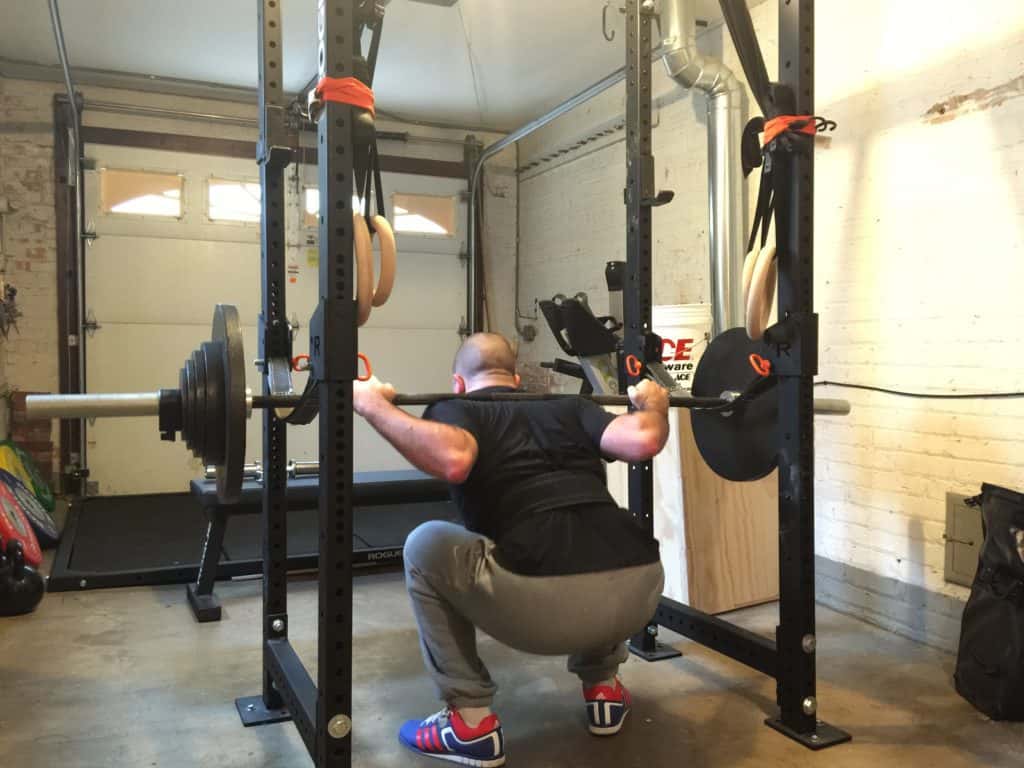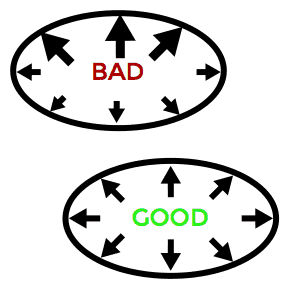Don’t Be Comfortable Under The Bar

The bar setup position should be uncomfortable but not painful. Create maximum tension in your upper back to form a solid shelf for the bar with the following steps:
- Pinch your shoulder blades together tightly. This bunches up your upper back musculature to form the shelf for the bar across your lower traps and rear deltoids.
- Grip the bar with your hands as close to your shoulders as possible while maintaining a neutral wrist. You may feel a significant stretch across your pectorals and front deltoids, especially if you have some residual bench press soreness.
- Lift your chest; puff it out. Achieve this with a firm thoracic spine extension.
- Lift your elbows, without dropping your chest. This will reinforce the stable muscle-shelf you have formed by following these steps.
Walk It Out Like A Boss
A strong confident squat is built on the back of a strong confident walkout. By practicing and perfecting a confident walkout in training, you set yourself up for massive PRs and you can rely on it to help you trudge through those heavy volume days where gravity seems extra mean. Here’s how:
- Un-rack it assertively and aggressively. Treat your un-rack like a squat: brace, breathe, and be as aggressive as you are during your squat. More on these later.
Don’t un-rack your squat like an old man: bent, broken and staggering. A 405 lb. squat can be un-racked by applying 406 lb. of upward force on the bar, or by applying 455 lb. of force to the bar. Which do you think a boss would do?
One cue that can help is to shove it out of the rack as opposed to “lifting” it out of the rack.
 Take three steps. First, step straight back with one leg; this prevents the plates from banging into the rack. Second, step back and out with the other foot, placing it exactly where it will be for your squat. Finally, shift the first foot to the proper squat width and position.
Take three steps. First, step straight back with one leg; this prevents the plates from banging into the rack. Second, step back and out with the other foot, placing it exactly where it will be for your squat. Finally, shift the first foot to the proper squat width and position.
It will take some time to truly get it down to just three steps. I still find myself making subtle shifts to get everything feeling “just right”. The key is to break the habit of walking it a half-mile out of the rack and then taking a half dozen micro-steps to get situated.
Breathe Into Your Belt
Taking a deep, full, diaphragmatic breath and bracing against your lifting belt increases your intra-abdominal pressure reinforcing your trunk and helps maintain your spinal position during the squat.
Take a deep breath and try to “fill out” the belt. Filling out the belt is key. One common novice mistake is to breathe only into the chest. This does not allow for optimal bracing and makes it quite impossible to squat heavy loads safely.

Watch out for another, more subtle, novice mistake: the hyper-extended, beer gut, frontal pressure belly breath (and, yes, I gladly welcome a simpler way of saying that). This happens when you take a deep belly breath into unbraced abdominal muscles, it causes your belly to protrude and often a slight hyper-extension through the lumbar spine. Instead, brace your abdominal muscles first, and focus on breathing evenly into all 360° of the belt as shown in the diagram.
A good cue for this is to breathe into your back
Fast Down, Blast Up
Many squats are missed simply because they aren’t fast enough. A fast powerful ascent is primed by a smooth, controlled, but fast descent. Some novice lifters seek out the bottom of the squat tentatively, creeping down like a three-toed sloth. This often leads to missing depth, but even when depth is achieved the stretch-reflex is muted or lost completely. More advanced lifters with limited mobility can miss depth by squatting too slow; sometimes you need that extra momentum to drive you below parallel.
Training your squat descent to be fast takes time and experience more than anything else. You need to have solid fundamentals: breathing, bracing, a rigid immobile spine, and a good base of strength. A fast descent is never simply relaxing and crumpling down ass-to-grass and hoping for a miracle to get back up. It’s always controlled, always confident, and always safe.
Teaching yourself the “blast up” part of the squat is a little easier. The secret: HIP DRIVE, hard and fast. Just like when you un-rack the bar, never settle for putting Just Enough™ effort into it. So you have 405 lb. on your back? Come out of the hole with a thunderous fury of 510 lb. upward force. Do this as your warm-ups approach your working weight for the day, and never let up.